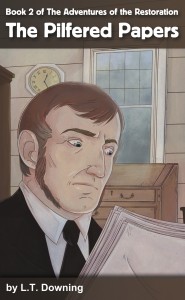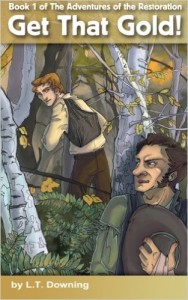Title: The Adventures of the Restoration Book 1-2
Author: L.T. Downing
Publisher: Zion Bookworks
Genre: Young Adult Fiction
Year Published: 2014/15
Binding: Paperback
ISBN10: 0615885527/149129955X
ISBN13: 978-0615885520/978-1491299555
Price: $10.95/$11.95
Reviewed by Kristie Wilkins for the Association for Mormon Letters.
Over the years many versions of the events leading up to and involved in the restoration of the Gospel have been written and shared. As Latter-Day Saints we believe that these events are the most critical events in the history of the world save the Atonement and Resurrection of the Savior. It is only natural that what happened during that time should intrigue the mind and capture the imagination. That the events that took place during the restoration were not only sacred in nature but an intense, dangerous and thrilling “adventure” is the premise of author L.T. Downing’s new series, “The Adventures of the Restoration.” In the first books of her series, Downing has chosen to highlight two pivotal moments in the bringing to light of “The Book of Mormon.” Here, briefly, are the historical periods covered by the narratives in each volume:
Book 1 “Get That Gold”
After years of waiting the time has finally arrived for Joseph Smith to obtain the sacred gold plates. While the entire Smith family is filled with anxious anticipation there is great cause for concern as well. Rumors about Joseph and his gold treasure have been circulating for some time and numerous men, many of whom the Smiths used to call friends, are plotting to catch Joseph in the act of retrieving the plates and steal them for themselves. “Get That Gold” is the story of the wild adventure Joseph and his enemies experience that fateful night.
 Book 2 “The Pilfered Papers”
Book 2 “The Pilfered Papers”
Joseph and Emma Smith, driven from their home in Palmyra, NY by vicious rumors and persecution, have settled in Harmony, PA near Emma’s parents. The work of the translation of the sacred record has begun and Joseph has made slow but steady progress with the help of Emma and family friend Martin Harris who has been traveling back and forth between Palmyra and Harmony to assist the young prophet. While Martin’s help has been gratefully received by the Smiths, Lucy Harris, Martins’s wife, could not be more displeased. A hard and sometimes vindictive woman, Mrs. Harris forces her husband to make a series of decisions that place the sacred record jeopardy as well as the prophet and Martin’s very souls.
Author L.T. Downing is a talented storyteller. Downing weaves fascinating and heart-pumping tales from LDS church history that make oft-told stories come alive. She has the ability to take her readers into the story so that they feel the emotions of her characters as they experience some of the most critical moments and turning points of the restoration of the Gospel.
Downing also captures the complexity and nuances of her character’s personalities. For example Lucy Harris, so often seen as a one dimensional villain in historical accounts, is portrayed as a complicated woman who struggles not only with her faith but with loneliness. She is shown as a woman who allows fear to drive her decisions to the point where, instead of drawing her husband home, she alienates him and drives him to make decisions that could ultimately destroy not only their marriage and his relationship with the prophet but his own soul as well. The reader can almost feel sorry for her at times and at others nothing but disdain.
At times I had a hard time reconciling Downing’s characterization of individuals with what I have read from historical accounts. In “Get that Gold,” for instance, Joseph Smith Sr. is portrayed as intense and even volatile, going to the extreme of ambushing Joseph and Emma on the road to drive home to Joseph the seriousness of the threats against him. This differs greatly from the strong, steadying influence Lucy Mack Smith describes in her accounts of her husband and his relationship with his son.
Naturally, one must allow for a certain amount of freedom to an author striving to present Church history in a way that is both interesting and exciting to young readers. Downing exercises her considerable talent in layering in some interesting dialogue and story elements that historians might find troubling.
Again, this is the nature of historical fiction. In order to tell a story, authors must be given the freedom to enhance the story to fit his or her intended reading audience. Downing knows her audience well! While I had some questions about some of characterizations, my son thought I was just crazy — he loved the books. And he, after all, is who Downing is writing for!
Downing makes it clear in the Author’s Notes at the end of both novels that her works are works of fiction. Real situations are portrayed but the author has added a significant amount of detail, dialogue and characterization from her own imagination. It is very apparent that the author has made a tremendous effort to do historical research on her subject but she does take a great deal of liberty in her tales. The art and magic of historical fiction is for the author to draw and flesh out a story from the faded pencil sketches of the records of the time combined with their own creativity, making history come alive for the reader.
The hazard of well written historical fiction is that often the reader becomes so engaged in the story that the lines between fact and fiction blur. This is why endnotes are so important. For example, in Gerald Lund’s newest series, “Fire and Steel,” he carefully annotates at the end of each chapter which of the story elements are from his imagination and which are from history. Perhaps such notes in the next volume in this series will assist young readers in understanding the factual basis behind the story.
As with earlier historical fiction, such as “The Work and the Glory,” these books merit a wide readership. They are sure to awaken a love for Church history in LDS youth, and will help build a testimony that will last them a lifetime. Young people have many years ahead of them to sort through what is fact and what is enhancement.
I hope to see more of this series and am fascinated with the idea of which “Adventure of the Restoration” she will choose to focus on next.

